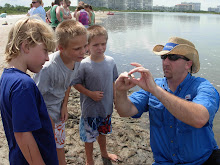
Today we had our first field trip for our spring Florida Master Naturalist Program class, and besides a little wind on the return boat trip, I don't think we could have asked for a better day. We took the group to Key Island (aka Keewaydin) to give them a lesson on barrier island ecology. This is always a great trip as its an excellent opportunity to see first hand several of the different coastal habitats associated with these dynamic landscapes. On top of that, we have a great class who is obviously interested in soaking up as much information as they can. As an instructor, I couldn't ask for a better situation. We did a walking transect of the island; first hiking through a tidal mangrove creek, then treking through a coastal strand (aka transition zone) environment, and finally beachcombing along Key Island's pristine beach system. My colleague and I had the class explore the beach on their own to see what kinds of interesting items they could find and share with the rest of the class. We weren't disappointed! Egg cases, sponges, sea beans, parchment worm casings, and pen shells were just some of the items they found. Enjoy the pictures!
 |
| Along our boat trip out to the island we stopped by one of Rookery Bay Reserve's data sondes that monitors water quality parameters within the reserve. |
 |
| Sarah Falkoski, Rookery Bay Education Specialist talks to the group about invasive species, specifically Australian Pines that you can see in the background. |
 |
| Once on the island, we were met by several fiddler crabs scurrying about on the exposed mud flats. Fiddler crabs are an excellent food source for many birds and fish; they also help aerate the oxygen-poor sediment through the excavation of their burrows. |
 |
| Here's me giving the class a field lesson on mangrove identification. Don't forget... "Red, red -shiny head"; Black, black-salt on back", and White white-sugar delight" |
 |
| Treking through a mangrove creek |
 |
| We stopped in a salt pan area to discuss how mangroves are adapted to living in saline conditions. |
 |
| Almost out of the mangroves! |
 |
| Our class hikes across the coastal transition zone (aka strand and/or scrub). Several of the pricky pair cacti we saw were in full bloom. They were beautiful! |
 |
| Sarah explains to the group the importance of sea oats and other dune vegetations to our beach environments. |
 |
| An overwash area from a recent spring high tide. |
 |
| beachcombina along Key Island's beach |
 |
| Filling in a VERY large hole someone left behind, and was not considerate enough to fill in thenselves. It must have been at least three feet deep and several feet wide. We might not think much about it, but for a sea turtle trying to nest on the beach, it could spell disaster! |
 Today we had our first field trip for our spring Florida Master Naturalist Program class, and besides a little wind on the return boat trip, I don't think we could have asked for a better day. We took the group to Key Island (aka Keewaydin) to give them a lesson on barrier island ecology. This is always a great trip as its an excellent opportunity to see first hand several of the different coastal habitats associated with these dynamic landscapes. On top of that, we have a great class who is obviously interested in soaking up as much information as they can. As an instructor, I couldn't ask for a better situation. We did a walking transect of the island; first hiking through a tidal mangrove creek, then treking through a coastal strand (aka transition zone) environment, and finally beachcombing along Key Island's pristine beach system. My colleague and I had the class explore the beach on their own to see what kinds of interesting items they could find and share with the rest of the class. We weren't disappointed! Egg cases, sponges, sea beans, parchment worm casings, and pen shells were just some of the items they found. Enjoy the pictures!
Today we had our first field trip for our spring Florida Master Naturalist Program class, and besides a little wind on the return boat trip, I don't think we could have asked for a better day. We took the group to Key Island (aka Keewaydin) to give them a lesson on barrier island ecology. This is always a great trip as its an excellent opportunity to see first hand several of the different coastal habitats associated with these dynamic landscapes. On top of that, we have a great class who is obviously interested in soaking up as much information as they can. As an instructor, I couldn't ask for a better situation. We did a walking transect of the island; first hiking through a tidal mangrove creek, then treking through a coastal strand (aka transition zone) environment, and finally beachcombing along Key Island's pristine beach system. My colleague and I had the class explore the beach on their own to see what kinds of interesting items they could find and share with the rest of the class. We weren't disappointed! Egg cases, sponges, sea beans, parchment worm casings, and pen shells were just some of the items they found. Enjoy the pictures!















No comments:
Post a Comment